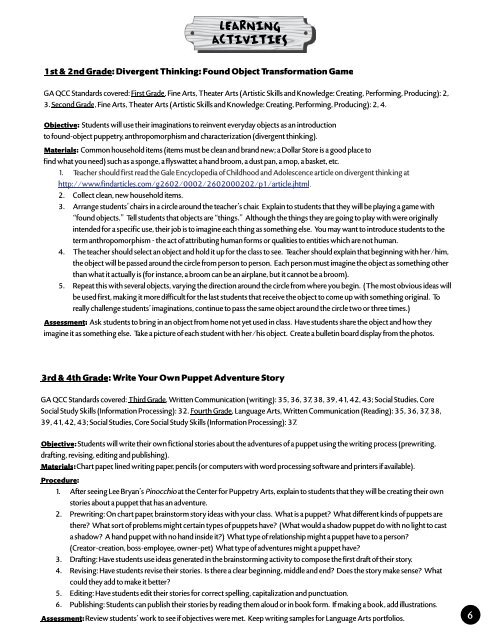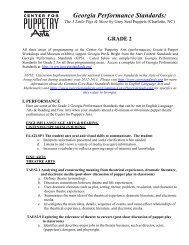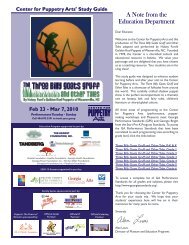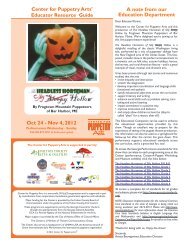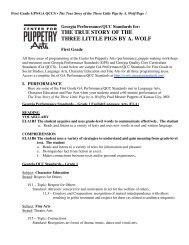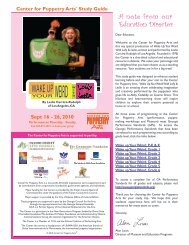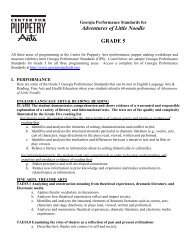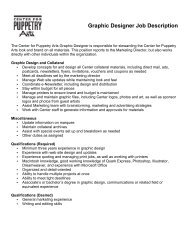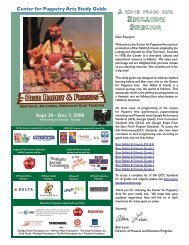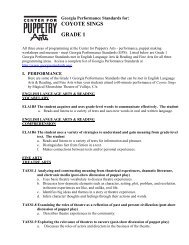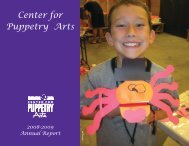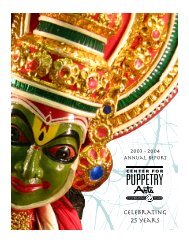Pinocchio - Center for Puppetry Arts
Pinocchio - Center for Puppetry Arts
Pinocchio - Center for Puppetry Arts
You also want an ePaper? Increase the reach of your titles
YUMPU automatically turns print PDFs into web optimized ePapers that Google loves.
learning<br />
activities<br />
1st & 2nd Grade: Divergent Thinking: Found Object Trans<strong>for</strong>mation Game<br />
GA QCC Standards covered: First Grade, Fine <strong>Arts</strong>, Theater <strong>Arts</strong> (Artistic Skills and Knowledge: Creating, Per<strong>for</strong>ming, Producing): 2,<br />
3. Second Grade, Fine <strong>Arts</strong>, Theater <strong>Arts</strong> (Artistic Skills and Knowledge: Creating, Per<strong>for</strong>ming, Producing): 2, 4.<br />
Objective: Students will use their imaginations to reinvent everyday objects as an introduction<br />
to found-object puppetry, anthropomorphism and characterization (divergent thinking).<br />
Materials: Common household items (items must be clean and brand new; a Dollar Store is a good place to<br />
f ind what you need) such as a sponge, a f lyswatter, a hand broom, a dust pan, a mop, a basket, etc.<br />
1. Teacher should f irst read the Gale Encyclopedia of Childhood and Adolescence article on divergent thinking at<br />
http://www.f indarticles.com/g2602/0002/2602000202/p1/article.jhtml.<br />
2. Collect clean, new household items.<br />
3. Arrange students’ chairs in a circle around the teacher’s chair. Explain to students that they will be playing a game with<br />
“found objects.” Tell students that objects are “things.” Although the things they are going to play with were originally<br />
intended <strong>for</strong> a specif ic use, their job is to imagine each thing as something else. You may want to introduce students to the<br />
term anthropomorphism - the act of attributing human <strong>for</strong>ms or qualities to entities which are not human.<br />
4. The teacher should select an object and hold it up <strong>for</strong> the class to see. Teacher should explain that beginning with her/him,<br />
the object will be passed around the circle from person to person. Each person must imagine the object as something other<br />
than what it actually is (<strong>for</strong> instance, a broom can be an airplane, but it cannot be a broom).<br />
5. Repeat this with several objects, varying the direction around the circle from where you begin. (The most obvious ideas will<br />
be used f irst, making it more diff icult <strong>for</strong> the last students that receive the object to come up with something original. To<br />
really challenge students’ imaginations, continue to pass the same object around the circle two or three times.)<br />
Assessment: Ask students to bring in an object from home not yet used in class. Have students share the object and how they<br />
imagine it as something else. Take a picture of each student with her/his object. Create a bulletin board display from the photos.<br />
3rd & 4th Grade: Write Your Own Puppet Adventure Story<br />
GA QCC Standards covered: Third Grade, Written Communication (writing): 35, 36, 37, 38, 39, 41, 42, 43; Social Studies, Core<br />
Social Study Skills (In<strong>for</strong>mation Processing): 32. Fourth Grade, Language <strong>Arts</strong>, Written Communication (Reading): 35, 36, 37, 38,<br />
39, 41, 42, 43; Social Studies, Core Social Study Skills (In<strong>for</strong>mation Processing): 37.<br />
Objective: Students will write their own f ictional stories about the adventures of a puppet using the writing<br />
process (prewriting,<br />
drafting, revising, editing and publishing).<br />
Materials: Chart paper, lined writing paper, pencils (or computers with word processing software and printers if available).<br />
Procedure:<br />
1. After seeing Lee Bryan’s <strong>Pinocchio</strong><br />
at the <strong>Center</strong> <strong>for</strong> <strong>Puppetry</strong> <strong>Arts</strong>, explain to students that they will<br />
be creating their own<br />
stories about a puppet that has an adventure.<br />
2. Prewriting: On chart paper, brainstorm story ideas with your class. What is a puppet? What different kinds of puppets are<br />
there? What sort of problems might certain types of puppets have? (What would a shadow puppet do with no light to cast<br />
a shadow? A hand puppet with no hand inside it?) What type of relationship might a puppet have to a person?<br />
(Creator-creation, boss-employee, owner-pet) What type of adventures might a puppet have?<br />
3. Drafting: Have students use ideas generated in the brainstorming activity to compose the f irst draft of their story.<br />
4. Revising: Have students revise their stories. Is there a clear beginning, middle and end? Does the story make sense? What<br />
could they add to make it better?<br />
5. Editing: Have students edit their stories <strong>for</strong> correct spelling, capitalization and punctuation.<br />
6. Publishing: Students can publish their stories by reading them aloud or in book <strong>for</strong>m. If making a book, add illustrations.<br />
Assessment: Review students’ work to see if objectives were met. Keep writing samples <strong>for</strong> Language <strong>Arts</strong><br />
portfolios.<br />
6


